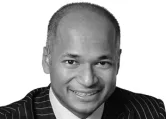The future of banking: More traditional than you'd think
By Moorad ChoudhryA combination of traditional banking values and omni-channel seamless customer service will ensure that vanilla commercial banks will always be an important part of the global economy.
It has become fashionable to sound the end of banks and banking. Recently the CEO of one of the new crop of digital "challenger" banks suggested that the banking model was broken and needed urgent fixing; according to some commentators P2P and FinTech are queuing up to take away banks' customer bases, the entry of Amazon into the lending market now means banks are finished, and it seems every time I pick up an inflight magazine there is an article gushing with excitement about how the latest non-bank start-up is going to take over the world of finance.
Who would be an old-fashioned commercial banker in 2015? It isn't only tough competition that might lead one to conclude that the future is bleak either; the need to comply with regulation introduced in the wake of the bank crash means that at some banks entire business lines are now unviable, while other banks will struggle to ensure compliance without long-term central bank support.
The future looks bleak. Or does it? It's easy to cherry pick certain customers and claim one is now a full-service bank. Equally it seems some new entrant banks offer such a limited product suite that they barely provide enough to still call themselves "banks".
Far from being broken, traditional commercial banks can ensure their continued relevance simply by doing well what they are already strong in, namely offering a full product set, whilst concentrating on working hard to ensure impeccable customer service.
Consider the customer service channel first. To still speak of "digital banking" in 2015 is to date oneself already: what is important is the customer interface, be it branch, phone, internet, mobile, or the latest "video" banking. Any bank worthy of the name must strive to offer this omni-channel service platform, in a way that is seamless and error-free.
Customers, like the banks that purport to service them, grow over time. As they age their service channel needs will alter. That doesn't mean a bank needs hundreds of branches to serve its entire geographical area: within Asian countries it would be sufficient to place a physical presence only in towns with a population greater than (say) 250,000 – call it the Apple store model. That is not a large number of branches in many countries.
Does a bank need any branches? Ask oneself if it realistic to expect that one's entire customer base will only ever need one service channel for their whole working life and into retirement. Should we expect thadt no customer ever will wish to discuss a residential mortgage or a business start-up loan face-to-face?
And let's not confuse customer interface with product. Banks are still the only institutions that provide the vital lubrication of commerce that is the current account and the on-demand overdraft. A stand-by liquidity facility is a lifeline for many small businesses. Is this a standard product of FinTech and other disintermediaries?
Banking is a product base as well as a customer interface. One can provide mobile financial services but one also has to provide the products that customers will require through the business cycle and over their lifetime.
The foregoing is not meant to suggest that traditional banks can sit back and ignore the competition – far from it. There is still much we need to improve, both in the technology space and in the area of customer service.
A recognised advantage of new challenger banks is that they do not suffer from unreliable legacy systems. But already we observe bank branches becoming the user-friendly environments that they should have been many years ago, and some banks are seeking to acquire the technical ability to understand their customers in the way that Amazon and Google can.
This is the consistent upside of competition. And so a worthy aim for a bank would be to treat every customer as a name and not a number.
But these are not insurmountable problems. The modern bank for the 21st century must provide a viable product suite for its entire customer franchise and deliver a concierge service. That's what any good bank today should be: a bank for everyone. The future is bright.












 Advertise
Advertise










